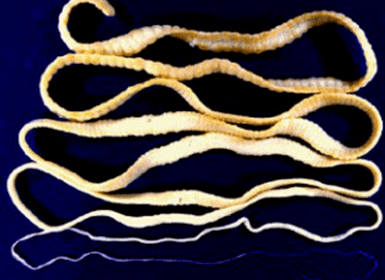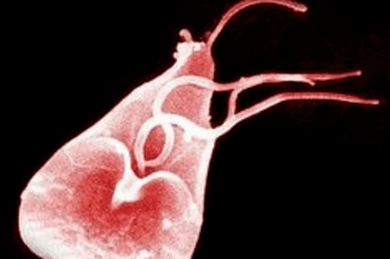The body's parasitic infection is a common phenomenon that tends to both children and adults (the first to a greater extent, since hygiene is worse).The internal parasites differ in the carrier at the site of the body, their characteristics, structure, life cycle, and more or less affect the carrier.Depending on the parasites of the human body, the symptoms may differ.

Type
Talking about what parasitic infection in the human organs, many patients think about worms.However, there are many other types of invasions.In the human body, the two types of parasites are the most common.They have a different life cycle and the nature of transmission because they need to be distinguished.
- The first type is worms living in the human body, also known as helmints or worms.The Hlybon invasion is primarily concentrated in the intestine, provides quite emphatic symptoms and can be easily diagnosed.In addition, it is usually easy to cure and usually does not cause serious damage to adults and children.Such parasites are available in two types - nematodes (round) and ribbons.It is distributed on the stool-oral route, that is, in order for parasites of the human body to appear, a significant amount of eggs must be swallowed, which are emitted by feces;
- Microscopic simple parasites within a person, amoeba, etc.Are not detected for the eyes.In this case, the signs of parasites in the body are more prominent.It is harder to cure them and it is quite difficult to diagnose, unlike the previous type.The effect of parasites on the human body is much more significant, such infections can lead to the development and worsening of chronic diseases, and even threaten life.The nature of transmission is stool-oral, sometimes blood and other ways.
It is very important to know what parasites live in the human body as it helps to avoid infection.
Type
Parasites cause various symptoms.Usually localized in the organ or system, which is amazed.Depending on the species, the body's parasites can lead to viability activity and can only multiply and multiply under certain circumstances.Based on this, they are conditionally divided into species:
- Bowel (primarily round and flat worms - Pinworms, Ascarides, tapworms);
- Liver (mainly microscopic protozoa - lamblia, etc.);
- Muscle (mainly microscopic);
- Joint (the same as in the previous case);
- Skin (micro-warm, fungi);
- Heart (primarily microscopic or damage to the helmin by larvae);
- Lungs (infection with worms);
- Brain (larva forms of worms and simple organisms);
- Parasite in human blood (microscopic protozoa);
- Genitalia in the uterus, vagina (usually worms, but the phenomenon is quite rare).

Each of the listed groups causes signs of certain parasites in the human body.Therefore, you need to know what to cause to diagnose the infection on time.
Localization
Although there are many places where the parasites live in the human body, as shown from the groups of the parasites listed above, the worms are the most common.These worms are localized, especially in the gut.Depending on the species, they can live in small or colon.They reproduce there, eggs and eat.That is, the active stages of their life cycle are in progress.
The parasites of these people have a migration stage when larvae are convinced and hit by other organs (lungs, liver, brain, heart, muscles, etc.).The reason for this is that they fall from the intestines to the local and then to the common bloodstream.So man's parasites fall into all organs and systems.But there they form a capsule around the larva and get into rest.At the same time, they cause inflammatory processes, abscesses and sepsis.
Other persons of a person, such as giardia, settle in the liver.They have the most favorable environment for them, so they are minimal in the intestine and other systems.The same lifestyle is a bicom.These parasites can involve a minimal part of their life cycle in the intestine, primarily affecting other organs.
Some parasitic organisms live on the body of the carrier.These are primarily one or another type of fungi.Depending on the species, they affect the skin, nails, scalp, and mucous membranes.Micro-Glow is another type of pest that lives on the skin and its upper layers.
General symptoms
The symptoms of the presence of parasites in the human body depend on the type of invasion that collided with the body.But almost everyone is characterized by two signs - poisoning and allergic syndrome.
- Poisoning develops as a result of body intoxication with parasites products.This is caused by absolutely all parasites of the body.This is expressed as a constant weakness of the carrier, the pallor, the increased fatigue, the chronic fatigue, the drowsiness.In children, poisoning is quite highly expressed in adults - to a lesser extent;
- The second general phenomenon that provokes parasites in the human body is the symptoms of allergy.The reason for this is that the immune system that tries to protect the body against a foreign agent triggers the active production of histamine.If a lot of blood accumulates in the blood, allergies will develop.Usually symptoms are predominantly skin - rashes, urticars, but can also be respiratory.
During the diagnosis of body parasites, the presence of specific immunoglobulins can be inferred in blood tests.Regardless of the nature of the invasive agent, the immune system creates specific antibodies to combat it.If there are such antibodies, there is an invasion in the body.And you can understand which one type of antibodies.
Special symptoms
How the parasites affect the body depends on their type.Each has specific symptoms of infection against parasites.Extra -curricular forms of infection with internal parasites (lambliosis, toxocarosis, opistor, etc.) and halmint invasions associated with active infection of the active infection of internal organs in the migration stage are particularly difficult.The first signs with this flow are as follows:
- Increasing body temperature, usually significant;
- Chills;
- Abundant sweating;
- Sometimes the lymph nodes grow;
- If the parasites collided with the lungs, there will be a slight cough that may increase over time and may even enter pneumonia;
- If the liver is defeated, it will increase and pain can be observed;
- Localized on the skin, rash and redness, peeling, itching appear;
- The abdomen can cause abdominal pain, bloating, bloating, nausea, weight loss, constipation or diarrhea;
- The heart, arrhythmia, tachicardia and other arrhythmias can be observed by localization of cardiovascular organs;
- Muscle and joint parasites do not pronounce and appear regularly in the affected areas.
It can be said that human parasites are present in the body, there may be other symptoms, but the above are the most typical.The most typical evidence is that the intestinal worms are in the body, the detection of individuals in a chair.
Treatment
Helmink or the simplest can live in a person for a long time without showing themselves.However, if the invasion is suspected, you should immediately diagnose and diagnose it.A parasitologist or infectious disease expert tells you how to treat the infection.
Helmint treatment is performed with anthelmintic drugs.All specific drugs are divided into two groups.Preparations with a widespread action spectrum kill several parasites and prescribe an unclear pathogen for invasion.The narrow spectrum formulations are prescribed when installing an invasion agent, less toxic.
One has to take such a drug once.After 7-10 days, a second bet is prescribed as a possible protection against possible self-cleaning.Occasionally, the medicine can be prescribed 3-5 days in a short period of time.The doses depend on the rate of invasion, the type of drug, the weight of the patient and other factors.



























